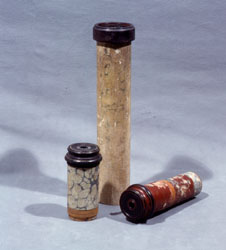 29. 22-foot telescope by G. Campani
29. 22-foot telescope by G. Campani
It is part of the Donations made to the Astronomical Room of the Institute of Science by Em. Cardinal Tanari in 1714, among which is mentioned "A Telescope by Campani 22 feet long, with four lenses and a cypress wood tube, kept in a cypress case."
The 7-draw octagonal tube, 13.5 cm wide and 150 cm long (closed) does not show much sign of wear and tear; it might well therefore have been built around the date of the donation.
The mounts of the eye-piece and object lens are missing. The eye-piece and object lens may have been re-used in the telescope mounting actually used - consisting of "A tin tube divided in two for the 23-foot object lens", as stated in the 1746 inventory, but not found - or else in a later wood mounting [file 31].
The object lens, in green-tinted glass with few large bubbles, has a 9.3 cm diameter, a focal length of 820 cm, equal to 21.5 Bolognese feet, an edge thickness of 0.4 cm and carries the words Giuseppe Campani in Roma.
Mounted on the Macchina di Lelli [file 31] together with an eye-piece of about 10 cm [Inv. MdS-62] it enlarged 80 times and was considered of excellent quality, enabling the user to discern the shadows the satellites of Jupiter threw on the disk of the planet at the moment of their transit. It was used to observe Uranus shortly after its discovery (13 March 1781) and the planetís disk seemed more sharply defined than by Dollondís long telescope, recently acquired by the Specola.
The tube was restored in 1993 by S. Salemme (Imola).
E. Baiada, A. Braccesi (1983), p. 88.
M.L. Righini Bonelli (1981).